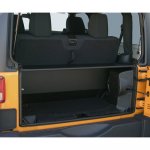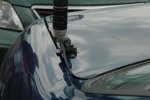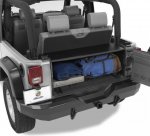11th
Member
OK, so it is a JK, I'm in a city and my JK is my daily driver as well, usage of amateur and GMRS will be limited to a few times a month east coast off road, mainly Shenandoah and norther Appalachians where repeaters are relatively rare compared to Rockies. I expect to be mainly simplex, but do want to practice repeaters for a trip out west this summer. It is parked outside in a city so I will probably have the antenna portion. I had a ham license back a million years ago in HS. I'm studying to get a tech ticket at the moment. In what is going to be an anathema to some, I just could not help it when camelcamel showed $18.50 for UV 5R and I grabbed a couple, but I do expect to get a mobile unit once I establish it will be best for me.
So I am up agains the normal Jeep Wrangler dual band antenna issues, along with my individual needs being in a city and needing a vehicle mounted dual band actually on the vehicle just a couple of times a month. The vehicle, despite being off road a fair amount the last four years is cherry, I also want to minimize the damage that does in fact occur from antennas. While a lip mount on front driver fender or close to it on hood is something I am considering, I have seen damage from those from simply getting caught in brush.
**First I have a question on terminology and function (and if if this part exists at all) of an antenna part. On JK rear tailgate upper hinge mounts, on on fender mounts, there is 3-4" inches of near vertical metal right next to antenna. To get above that would require an extension of the mount. a) do such things exist? b) should they be non conductive to avoid becoming part of the antenna and detuning it? I see springs on CB type installs, but from what I read this requires antenna trimming or tuning somehow for vhf/uhv dual band) If such a component exists, is there a name for them? I looked under various names such as "riser" or "spacer" and saw nothing.
Second question would be concerning grounding. Tailgate and hood are grounded by hinges (mediocre) and by latches (better) but maybe some of these installs would be significantly better with groundstrap. I do know that electric items on the tailgate are wired both positive and ground, So FCA does not consider tailgate a dead certain ground.
1) mag mount on hood cowl (pic 1a)
Pros: Somewhat asymmetric ground plane but only standard install with a ground plane I also see cowl mounting that isn't a mag mount (1b), that is way easier on newer JL, and I have a JK
Cons: Some damage possibility to paint, but there are ways to avoid most of that risk.
2) fender /hood side edge mount:
Pros: half a ground plane if a riser can be placed.
Cons: if no riser mechanism is available, then a) below ground plane of hood, vertical 3-4" inches of hood right next to lower part of antenna, and way way asymmetric, as hood is is effective as ground plane (pics 2a and b). Risk of body repair requirement damage is possible especially when off road (see pic #2b)
3) tail light mount (not available on JK years due to very weak taillight attachment, prior years allowed very stout mount)
4) Bumper attachment: I am not considering this
5) A-pillar light mount based mount. 1" from vertical steel surface. Not considering it.
6) Security deck mag or non mag mount: (se pic 6a for deck)
pros: something of a ground plane (after ground strap it). it is a flat steel surface that is 13" by 39", all inside but above tub. No body damage potential. No corrosion issues.
cons: limited height 27" when roof is up, unlimited when roof is off. Proximity to rear passengers? virtually all off roading is just two in front seat.
7) Rear tailgate hinge mount: see pic 7a
Pros: little damage potential. high enough to clear tub with a 2" rise of some kind. Also far enough from tire and wheel that blocked area is probably only 30 degrees out of 360 from spare if no riser is used.
Cons: no ground plane. 30 degrees of circle has substantial metal in the way unless some kind of 12" riser is used. Mount is protected off road being at rear, but does not look robust for tall antenna.
8) spare based mount with mount at slightly above spare. Pic 8a
Pros: High. no blockage from talgate metal. No blockage from spares wheel. No blockage from tire, especially if steel belted as many off road tires are
Cons: Not for anyone who is going to use it full time and has garage or uses parking garages. No close grounds plane. Extreme height result (that is a pro and con)
#s 6,7,8 are most protected from trail damage. That is a concern since on-trail would be majority of usage. I am at this point tempted most by #6 to start. If I decide to go with something lese having a mag mount wont be a problem as I can use it ad hoc for our other vehicles , and if I drill a hole for mount there I wont really be upset or worry about corrosion since it is an interior spot.
so in the spirit of nothing being all right or all wrong, do let me know of any major missing pros or cons you can see. I have seen all these set ups on the trail over the past few years. When it comes to people reporting reception though it is pretty much all anecdote with zero controls for severe variables.
Here are the pics:
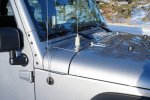
1a (above): magnet. User reports after four years no scratches or harm to cowl
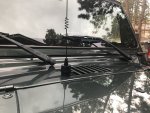
1b above, "Just jeff" install, no mag hood
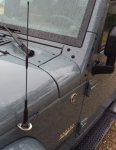
2a above. Fender, 3-4" of lower part of antenna below ground plane and against near vertical of hood
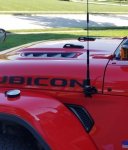
2b above. Same issues? Also ground strap like tail gate?
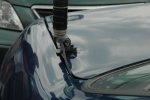
2c above potential damage from lip and side mounts
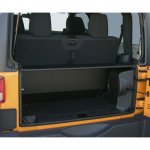
6a above, flat steel security deck surface at tub height. 13"x39" with 27" of height potential. will riders get fried at 5 watts from HT? grounstrapping this would be easy if needed.
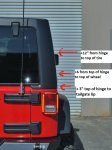
7a above. JK hinge mount. To get to tub height blocking 180 forward at base of antenna would need 2"-3" rise. another 5" to get above spare wheel blocking 30 degrees, and total of 12" to get above spare if steel belted. ground strap to tailgate?

8a above: rocky road mount, gets fully above tailgate vertical, and full above wheel and spare/ ground strap to tailgate?
So I am up agains the normal Jeep Wrangler dual band antenna issues, along with my individual needs being in a city and needing a vehicle mounted dual band actually on the vehicle just a couple of times a month. The vehicle, despite being off road a fair amount the last four years is cherry, I also want to minimize the damage that does in fact occur from antennas. While a lip mount on front driver fender or close to it on hood is something I am considering, I have seen damage from those from simply getting caught in brush.
**First I have a question on terminology and function (and if if this part exists at all) of an antenna part. On JK rear tailgate upper hinge mounts, on on fender mounts, there is 3-4" inches of near vertical metal right next to antenna. To get above that would require an extension of the mount. a) do such things exist? b) should they be non conductive to avoid becoming part of the antenna and detuning it? I see springs on CB type installs, but from what I read this requires antenna trimming or tuning somehow for vhf/uhv dual band) If such a component exists, is there a name for them? I looked under various names such as "riser" or "spacer" and saw nothing.
Second question would be concerning grounding. Tailgate and hood are grounded by hinges (mediocre) and by latches (better) but maybe some of these installs would be significantly better with groundstrap. I do know that electric items on the tailgate are wired both positive and ground, So FCA does not consider tailgate a dead certain ground.
1) mag mount on hood cowl (pic 1a)
Pros: Somewhat asymmetric ground plane but only standard install with a ground plane I also see cowl mounting that isn't a mag mount (1b), that is way easier on newer JL, and I have a JK
Cons: Some damage possibility to paint, but there are ways to avoid most of that risk.
2) fender /hood side edge mount:
Pros: half a ground plane if a riser can be placed.
Cons: if no riser mechanism is available, then a) below ground plane of hood, vertical 3-4" inches of hood right next to lower part of antenna, and way way asymmetric, as hood is is effective as ground plane (pics 2a and b). Risk of body repair requirement damage is possible especially when off road (see pic #2b)
3) tail light mount (not available on JK years due to very weak taillight attachment, prior years allowed very stout mount)
4) Bumper attachment: I am not considering this
5) A-pillar light mount based mount. 1" from vertical steel surface. Not considering it.
6) Security deck mag or non mag mount: (se pic 6a for deck)
pros: something of a ground plane (after ground strap it). it is a flat steel surface that is 13" by 39", all inside but above tub. No body damage potential. No corrosion issues.
cons: limited height 27" when roof is up, unlimited when roof is off. Proximity to rear passengers? virtually all off roading is just two in front seat.
7) Rear tailgate hinge mount: see pic 7a
Pros: little damage potential. high enough to clear tub with a 2" rise of some kind. Also far enough from tire and wheel that blocked area is probably only 30 degrees out of 360 from spare if no riser is used.
Cons: no ground plane. 30 degrees of circle has substantial metal in the way unless some kind of 12" riser is used. Mount is protected off road being at rear, but does not look robust for tall antenna.
8) spare based mount with mount at slightly above spare. Pic 8a
Pros: High. no blockage from talgate metal. No blockage from spares wheel. No blockage from tire, especially if steel belted as many off road tires are
Cons: Not for anyone who is going to use it full time and has garage or uses parking garages. No close grounds plane. Extreme height result (that is a pro and con)
#s 6,7,8 are most protected from trail damage. That is a concern since on-trail would be majority of usage. I am at this point tempted most by #6 to start. If I decide to go with something lese having a mag mount wont be a problem as I can use it ad hoc for our other vehicles , and if I drill a hole for mount there I wont really be upset or worry about corrosion since it is an interior spot.
so in the spirit of nothing being all right or all wrong, do let me know of any major missing pros or cons you can see. I have seen all these set ups on the trail over the past few years. When it comes to people reporting reception though it is pretty much all anecdote with zero controls for severe variables.
Here are the pics:

1a (above): magnet. User reports after four years no scratches or harm to cowl

1b above, "Just jeff" install, no mag hood

2a above. Fender, 3-4" of lower part of antenna below ground plane and against near vertical of hood

2b above. Same issues? Also ground strap like tail gate?

2c above potential damage from lip and side mounts

6a above, flat steel security deck surface at tub height. 13"x39" with 27" of height potential. will riders get fried at 5 watts from HT? grounstrapping this would be easy if needed.

7a above. JK hinge mount. To get to tub height blocking 180 forward at base of antenna would need 2"-3" rise. another 5" to get above spare wheel blocking 30 degrees, and total of 12" to get above spare if steel belted. ground strap to tailgate?

8a above: rocky road mount, gets fully above tailgate vertical, and full above wheel and spare/ ground strap to tailgate?


